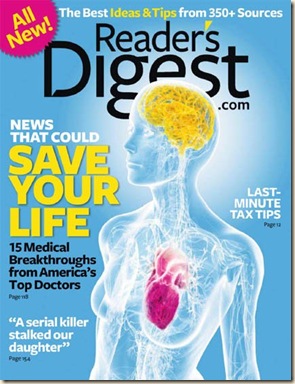Growing up, I was a huge Reader’s Digest fan. The magazine arrived every month at our house and as soon as I could pry it away from my parents, I read it cover-to-cover. They also bought the Readers Digest Condensed Books, which if not an outright sacrilege was at least an abomination. I will have to admit though, some of those condensed versions actually improved on the originals.
I know I couldn’t do it now to save my soul, but for a while in college I was actually literate enough to read and appreciate the Spanish language version - Selecciones from Mexico and the French Sélection from Canada.
As a kid, I loved the “First Person” articles, the “Quotable Quotes," the “Word Power” quizzes and the jokes in “Laughter – the Best Medicine” and “Humor in Uniform.” Mostly I searched the magazine for the little two or three line fillers that were dropped in to close out the page at the end of an article.
I had no idea that the magazine was still in print, but a check on line shows that it does. Just type in www.readersdigest.com and you’ll find that you can save 79% on a subscription.
[Editor’s note: I clicked just to make sure the link worked and that 79% now reads 81% – I have no idea what it might read if you check their website. In any case, I feel sorry for any poor fool that actually pays retail.]
I was only about nine or ten years old when the Digest published the couplet below. Something about it made it stick in my memory for the last fifty years.
Mary bought a pair of skates upon the ice to frisk.
Wasn’t she a brave young thing her little *

... her little ass to risk....?
ReplyDeleteFrom Wikipedia -
ReplyDeleteAn asterisk (*; Late Latin: asteriscus, from Greek: ἀστερίσκος, asteriskos, or "astress")[1] is a typographical symbol or glyph. It is so called because it resembles a conventional image of a star. Computer scientists and mathematicians often pronounce it as star (as, for example, in the A* search algorithm or C*-algebra). In English, an asterisk is usually five-pointed in sans-serif typefaces, six-pointed in serif typefaces, and six- or eight-pointed when handwritten.
The asterisk is derived from the need of the printers of family trees in feudal times as a symbol to indicate date of birth. The original shape was seven-armed,[citation needed] each arm like a teardrop shooting from the center. For this reason, in some computer circles it is called a splat,[citation needed] perhaps due to the "squashed-bug" appearance of the asterisk on many early line printers.[citation needed] Many cultures have their own unique versions of the asterisk.
In computer science, the asterisk is commonly used as a wildcard character, or to denote pointers, repetition, and multiplication.
Amazing Bob, Reader's Digest was one of my favorite sources of reading intertainment. In fact, I attribute my love of reading to Reader's Digest. My mother knew this and would renew my subscibtion every year as one of her Christmas presents to me. Kirk Dabney
ReplyDelete